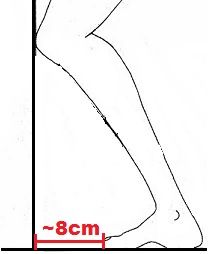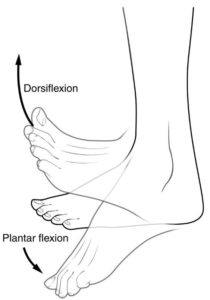That’s a Stretch: Why Stretching May Not Always be the Solution

It’s good to stretch a dollar. It’s bad to stretch the truth. But what about stretching your calves? That might depend on whether you believe Dr. Google every time a search result says to stretch sore calves.
Calf stretching aims to increase the range of motion (ROM) for ankle dorsiflexion. “Dorsi” is a prefix meaning “back”, and “flexion” is the action of bending. Ankle dorsiflexion is movement of the back of the foot upwards bringing the foot closer to the shin, or when bearing weight bringing the lower leg towards the foot.

There is a great deal of literature suggesting that limited ROM for ankle dorsiflexion contributes too many injuries. Dr. Google has very little information suggesting that excessive ROM for dorsiflexion contributes to injury. But experience with my patients shows me that it is possible to do too much calf stretching. I’ve noticed over the years that my patients with lower extremity injuries often demonstrate excessive ankle dorsiflexion and less frequently show limited dorsiflexion. Perhaps my patient population is skewed because they visited Dr. Google before seeing me.
What is considered a normal ROM for dorsiflexion, rather than too much or too little? And how can an individual self-assess to tell Dr. Google their ankle dorsiflexion ROM? Knowing this ROM is essential in determining whether stretching exercise is indicated. Pain should not be the indication to do stretching exercise. Limited ROM should be the indication for stretching exercise.
A good self-assessment is the knee to the wall test.

Start with toes against the wall and heel down on the ground. Keeping heel on ground, progressively slide the foot back from the wall and keep the knee touching the wall. When the heel comes of ground in order to keep the knee on the wall, which is the end point of the test. Measure how many inches away from the wall the toe is.
- Less than 2” indicates limited ankle dorsiflexion ROM
- 2” to 4” indicates normal ankle dorsiflexion ROM
- Greater than 4” indicates excessive ankle dorsiflexion ROM
- Greater than ½” difference between the right and left ankle is also significant. If the toe on the painful side is closer to the wall, stretching is indicated. If the toe on painful side is farther from the wall, then do NOT stretch.
In addition to excessive knee to wall measure, additional signs of excessive ankle dorsiflexion ROM include:
- Gait deviations of prolonged heel contact:
When walking, if the heel stays on the ground beyond the time when the opposite heel hits the ground, it is consider prolonged and excessive dorsiflexion.
- Gait deviation diminished/insufficient up and down motion:
When walking/running if gait is described as shuffling lacking or spring in the step is suggests excessive dorsiflexion
- Weak ankle plantar flexion:
See this article on how to test for weakness of ankle plantar flexor muscles.
- Visibly smaller and softer calf muscle(atrophy) relative to non-injured side.
What kinds of problems can occur with excessive dorsiflexion?
Though Achilles problems are often associated with limited ankle dorsiflexion, they can also occur with excessive ankle dorsiflexion. Tendinopathy of the posterior tibia tendon and peroneal tendon can occur with excessive dorsiflexion. Plantar heel pain can occur with excessive dorsiflexion, as can anterior hip/groin pain, ankle pain impingement, rupture or tear of the calf muscle, weakness associated with sciatic nerve injury, and increased risk of falls in the elderly.
What explains excessive ankle dorsiflexion?
The obvious explanation is a history of prior traumatic injury such as a muscle tear or rupture of the Achilles tendon. Surgical repair of a rupture Achilles tendon ideally repairs the injury to the original length, but less than optimal surgical repair can occur, or overly aggressive rehabilitation of the rupture can occur.
A less obvious explanation is an overdose of Dr. Google’s recommendation to do stretching exercises for pain. Often the thinking is: “If I stretch sooner, do it more, and do it longer then it will speed up the healing process. If it is not responding then maybe I am not doing enough and I need more stretching.” This is analogous to: “If I take more aspirin I can get rid of the pain.” But too much aspirin can lead to bleeding gastrointestinal ulcers and visits to the emergency room. More is not always better.
Despite Dr. Google’s advice, pain is not an indication that stretching exercise is needed. A sensation of tightness is not necessarily an indication that stretching exercise is needed. Painful Achilles are often described or perceived as feeling tight. A tight sensation can occur because the muscle tendon unit is chronically in a position of stretch not necessarily because the muscle tendon unit is relatively short. Perhaps a better adjective to describe what the Achilles pain feels like is “it feels taut”. A simple treatment for something that is taut is to put it in a position of slack. The indication for stretching exercises is limited range of motion.
What if I have excessive ankle dorsiflexion?
Don’t do calve stretching exercises. The muscle tendon unit needs to become stiffer and shorter. Avoid stretching. Don’t do Achilles strengthening exercise of “heel drops” on a step. Each time the heel drops below level the Achilles is being stretched unnecessarily. Do not walk/run barefoot. Don’t use night splints to stretch the calf and plantar fascia.
Position the calf muscles in a slack position. Wear high heel sneakers, shoes with a bit of a higher heel on the sole of shoe. Consider using a heel lift in or on the shoe during the healing process. Consider selecting shoes with a rocker sole. Consciously modify habitual walking and running by consciously propelling up and forward like you are peering over the crowd in front of you
Do heel raise exercise to strengthen the ankle plantar flexor muscles. Precision is important when doing heel lift strengthening exercises:
- Lift/propel straight up, and do not lean or sway forward. Try standing in a doorway and using the door frame as a reference to ensure that you are not swaying forward.
- Image you are standing in wet sand, and push the big toe downward, as if leaving an imprint in the sand. This will prevent rolling the foot outward in a supination motion, in which there is more pressure on the little toe side of the foot.
- Rise up as high as possible complete the full range of motion. It is important for the calve muscles to be contracting when the muscle tendon unit is at the shortest length.
- Come down as slowly as you go up - do not plop down. Come down to level ground.
- Being able to perform 20 to 25 unilateral heel raises to the same height as bilateral heel raises is considered normal ankle muscular endurance for an adult.
Consider the alternative

If stretching exercises are not working consider the alternative
Question – Confused – Better Idea
A better idea is as follows:
Pain occurs because movement is limited, restricted, and needs to be mobilized, or pain occurs because movement is excessive, too lax, and needs to be stabilized.
Pain is not an indication to do stretching exercise.
Sensation of tightness is not an indication to do stretching exercises.
Limited ROM is an indication to do stretching exercises.
Damien Howell Physical Therapy – 804-647-9499 – Fax: 866-879-8591 At-Home, At Office, At Fitness Facility – I come to you, I do home visits Damien@damienhowellpt.com
